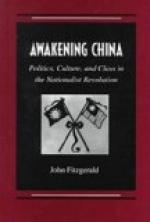Another claim to distinction not to be overlooked is that its river is a trap for whales. Seven or eight years ago a cetaceous monster was stranded near the [Page 24] river’s mouth. The Rev. Dr. Judson, president of the Hangchow Mission College, went to see it and sent me an account of his observations. He estimated the length of the whale at 100 feet; the tail had been removed by the natives. To explain the incident it is necessary to say that, the bay being funnel-shaped, the tides rise to an extraordinary height. Twice a month, at the full and the change of the moon, the attractions of sun and moon combine, and the water rushes in with a roar like that of a tidal wave. The bore of Hangchow is not surpassed by that of the Hooghly or of the Bay of Fundy. Vessels are wrecked by it; and even the monsters of the deep are unable to contend with the fury of its irresistible advance.
[Page 25] CHAPTER V
PROVINCE OF KIANGSU
Nanking—Shanghai—The Yang-tse Kiang—The Yellow River
Bordering on the sea, traversed by the Grand Canal and the Yang-tse Kiang, the chief river of the Empire, rich in agriculture, fisheries, and commerce, Kiangsu is the undisputed queen of the eighteen provinces. In 1905 it was represented to the throne as too heavy a burden for one set of officers. The northern section was therefore detached and erected into a separate province; but before the new government was organised the Empress Dowager yielded to remonstrances and rescinded her hasty decree—showing how reluctant she is to contravene the wishes of her people. What China requires above all things is the ballot box, by which the people may make their wishes known.
The name of the province is derived from its two chief cities, Suchow and Nanking. Suchow, the Paris of the Far East, is coupled with Hangchow in a popular rhyme, which represents the two as paragon cities:
"Shang yu t’ien t’ang hia yu Su-Hang."
“Su and Hang, so rich and fair,
May well with Paradise compare.”
[Page 26] The local dialect is so soft and musical that strolling players from Suchow are much sought for in the adjacent provinces. A well-known couplet says:
“I’d rather hear men wrangle
in Suchow’s dulcet tones
Than hear that mountain jargon, composed
of sighs and groans.”
Farther inland, near the banks of the “Great River,” stands Nanking, the old capital of the Ming dynasty. The Manchus, unwilling to call it a king, i.e. seat of empire, changed its name to Kiangning; but the old title survives in spite of official jealousy. As it will figure prominently in our history we shall not pause there at present, but proceed to Shanghai, a place which more than any other controls the destinies of the State.
Formerly an insignificant town of the third order (provincial capitals and prefectural towns ranking respectively first and second), some sapient Englishman with an eye to commerce perceived the advantage of the site; and in the dictation of the terms of peace in 1842 it was made one of the five ports. It has come to overshadow Canton; and more than all the other ports it displays to the Chinese the marvels of Western skill, knowledge, and enterprise.




